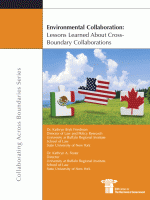
Environmental Collaboration: Lessons Learned About Cross-Boundary Collaborations

While they find that many of the elements necessary for effective collaborative ventures are critical — such as a clear purpose, dedicated staff, and the willingness to be flexible — they conclude that a bilateral collaborative venture is often more effective when it has a formal legal structures in place that enhance its legitimacy in the eyes of various stakeholders. Informal collaborations are often useful precursors to more formal efforts. These informal
efforts are often not seen as having the necessary legitimacy and resources in order to be as effective as their more formal counterparts.
This report continues a series of research efforts sponsored by the IBM Center that examines multi-stakeholder collaborative efforts in different policy
arenas that are “day-to-day efforts” and not crises. These include: Designing and Managing Cross-Sector Collaboration: A Case Study in Reducing Traffic Congestion, by John Bryson, Barbara Crosby, Melissa Stone, and Emily Saunoi-Sandgren, and more recently Strategies for Supporting Frontline Collaboration: Lessons from Stewardship Contracting, by Cassandra Moseley.
Each of these reports highlight a common success factor: the need for leaders who are passionate about reaching a common goal, have a broad network of peers, and the respect and trust of various stakeholders. As Admiral Allen says, “What’s needed are people who are adaptable, flexible,
and engaged in life-long learning, and are capable of understanding the problem.” These characteristics are frequently seen in each of the IBM Center’s recent reports on collaboration.
These reports point to the importance of developing a governance framework that is seen as legitimate, so stakeholders can then collaborate rather than compete. This factor may be key to sustaining successful “day-to-day” collaborative efforts over time. We trust that this report will be helpful to government executives as they continue to work with and form collaborative initiatives across a variety boundaries.



